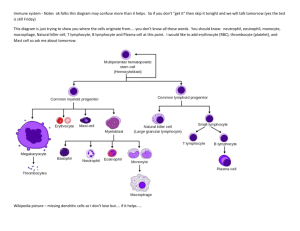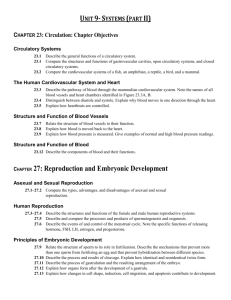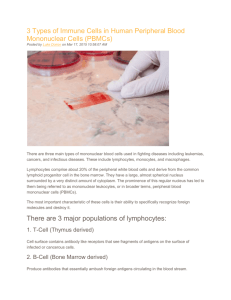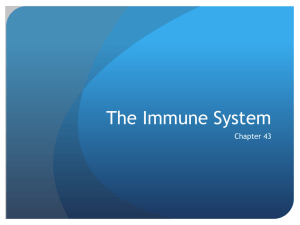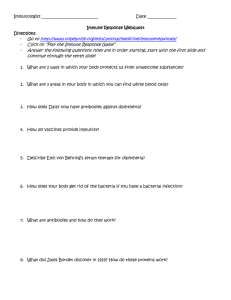I-Innate immune system
advertisement
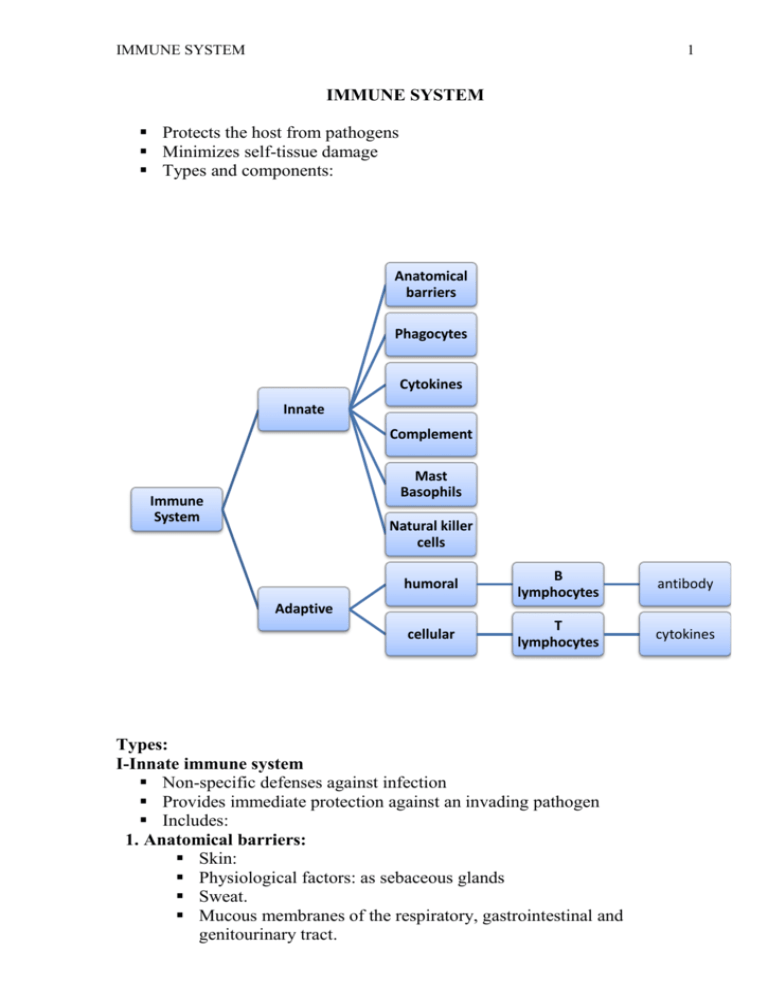
IMMUNE SYSTEM
1
IMMUNE SYSTEM
Protects the host from pathogens
Minimizes self-tissue damage
Types and components:
Anatomical
barriers
Phagocytes
Cytokines
Innate
Complement
Mast
Basophils
Immune
System
Natural killer
cells
humoral
B
lymphocytes
antibody
cellular
T
lymphocytes
cytokines
Adaptive
Types:
I-Innate immune system
Non-specific defenses against infection
Provides immediate protection against an invading pathogen
Includes:
1. Anatomical barriers:
Skin:
Physiological factors: as sebaceous glands
Sweat.
Mucous membranes of the respiratory, gastrointestinal and
genitourinary tract.
IMMUNE SYSTEM
2
Endogenous commensal bacteria
2. Phagocytes:
Specialized cells
Ingest and kill microorganisms, scavenge cellular and infectious debris,
and produce inflammatory molecules which regulate other components
of the immune system.
Crucial for defense against bacterial and fungal infections
Include:
a) Neutrophils (polymorphonuclear leucocytes)
Derived from the bone marrow and circulate freely in the blood
Short half-life of 6 hours
Functions:
1. kill microorganisms directly
2. facilitate the rapid transit of cells through tissues
3. non-specifically amplify the immune response
b) Monocytes and macrophages
Monocytes are the precursors of tissue macrophages
Produced in the bone marrow and exported to the circulation
After 7-10 hours in the blood stream, they migrate to peripheral tissues
where they differentiate into tissue macrophages and reside for long
periods
Specialized populations of tissue macrophages include Küpffer cells in
the liver, alveolar macrophages in the lung, mesangial cells in the
kidney, and microglial cells in the brain
Functions:
1. Initiation and amplification of the inflammatory response
2. Killing of microorganisms
3. Resolution and repair of inflammation
4. Link between innate and adaptive immune system
3. Cytokines:
Small soluble proteins
Act as multipurpose chemical messengers
Produced by cells involved in innate and adaptive immune responses and
by stromal tissue
IMMUNE SYSTEM
3
4. Complement
A group of more than 20 tightly regulated, functionally linked proteins
Promote inflammation and eliminate invading pathogens
Produced by the liver
Present in the circulation as inactive molecules.
Pathway:
a. The alternative pathway is directly triggered by binding of C3 to
bacterial cell wall.
b. The classical pathway is initiated when IgM or IgG antibody binds to
antigen, forming immune complexes.
c. The lectin pathway is activated by the direct binding of mannosebinding lectin to microbial cell surface carbohydrates
IMMUNE SYSTEM
4
Functions:
1. Defense against encapsulated bacteria such as Neisseria spp. and
Haemophilus influenza
2. Act as opsonins, rendering microorganisms more susceptible to
phagocytosis by macrophages and neutrophils
3. Chemotactic agents: promoting leucocyte trafficking to sites of
inflammation
4. Some fragments act as anaphylotoxins, binding to complement
receptors on mast cells and triggering release of histamine, which
increases vascular permeability
5. Target immune complexes to antigen-presenting cells, providing a
link between the innate and the acquired immune systems
6. Dissolve the immune complexes that triggered the cascade,
minimising bystander damage to surrounding tissues.
IMMUNE SYSTEM
5
5. Mast cells and Basophils:
Are bone marrow-derived cells
Play a central role in allergic disorders
Mast cells reside predominantly in tissues exposed to the external
environment, such as the skin and gut
Basophiles are located in the circulation and are recruited into tissues
in response to inflammation
Both contain large cytoplasmic granules which enclose preformed
vasoactive substances such as histamine. Additional mediators are
synthesised de novo after activation, including leukotrienes,
prostaglandins and cytokines
6. Natural killer cells:
Large granular lymphocytes
Play a major role in defense against tumours and virally infected cells
Express features of both the adaptive and innate immune systems
Morphologically similar to lymphocytes and recognise similar ligands,
but they are not antigen-specific and cannot generate immunological
memory
Express a variety of cell surface receptors
stress signals
absence of HLA molecules on the surface
binding of antigen-bound IgG antibody to surface receptors.
II. Adaptive immune system:
Has exquisite specificity
Highly adaptive, takes more time to develop but confers long-lasting
protection.
Possesses immunological memory
Types:
1. humoral immunity: produced by B lymphocytes, mediated by
antibody
2. cellular immunity: mediated by T lymphocytes, which synthesise
and release cytokines that affect other cells.
1. Humeral immunity
-B-lymphocyte:
Specialized cells arise from haemopoietic bone marrow stem cells
Major function is to produce antibody
Mature B lymphocytes can be found in the bone marrow, lymphoid
tissue, spleen, and to a lesser extent the blood stream
Express a unique immunoglobulin receptor on their cell surface (the Bcell receptor), which binds to soluble antigen
IMMUNE SYSTEM
- Immunoglobulin:
Soluble proteins made up of two heavy and two light chains
The heavy chain determines the antibody class or isotype, i.e. IgG, IgA,
IgM, IgE, IgD
Subclasses of IgG ( IgG1,2,3,4) and IgA(IgA1,2) also occur
- Antibody Function:
Facilitate phagocytosis by acting as opsonins
Facilitates cell killing by cytotoxic cells, particularly natural killer
cells
Trigger activation of the classical complement pathway
May act directly to neutralise the biological activity of their antigen
target.
6
IMMUNE SYSTEM
7
2. Cellular immunity:
T lymphocytes mediate cellular immunity
Function:
1) Defense against viruses, fungi and intracellular bacteria.
2) Immunoregulatory role
Leucocyte cell surface molecules are named by differentiation (CD)
antigen number
T lymphocyte type:
1) CD8+ ('cytotoxic') T lymphocytes
Specialized cells
Recognize antigenic peptides in association with HLA class
I (HLA-A, HLA-B, HLA-C)
IMMUNE SYSTEM
8
Kill infected cells directly through the production of poreforming molecules such as perforin, or by triggering
apoptosis of the target cell
Secrete cytokines such as IFN-γ which have antiviral
activity
+
2) CD4 ('helper') T lymphocytes:
Recognize peptides presented on HLA class II molecules
(HLA-DR, HLA-DP and HLA-DQ)
Have immunoregulatory functions
Produce cytokines and provide co-stimulatory signals that
support the activation of CD8+ T lymphocytes and assist the
production of mature antibody by B cells
Interact closely with phagocytes which determine cytokine
production by both cell types.
CD4+ lymphocytes can be subdivided into:
1) Th1 cells:
Produce IL-2, IFN-γ and TNF-α
Support the development of delayed type
hypersensitivity responses
2) Th2 cells:
Secrete IL-4, IL-5 and IL-10
Promote allergic responses
3) Regulatory cells:
Regulate other CD4+ cells
Prevent autoimmune disease.
